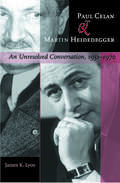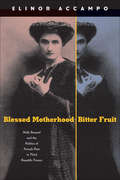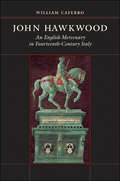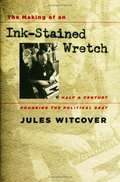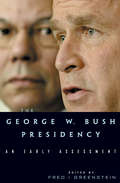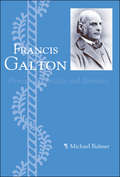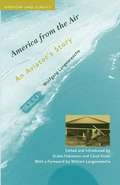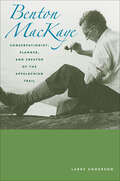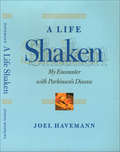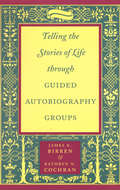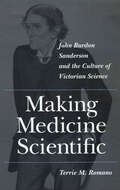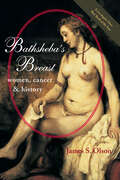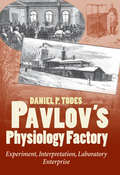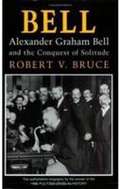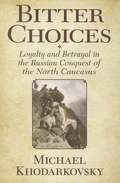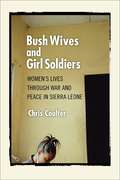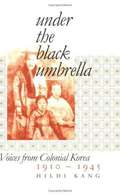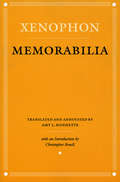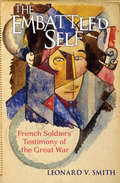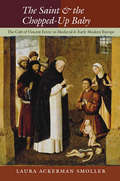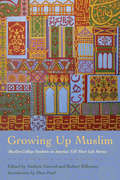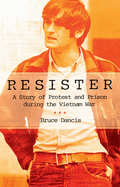- Table View
- List View
Paul Celan and Martin Heidegger: An Unresolved Conversation, 1951–1970
by James K. LyonThis work explores the troubled relationship and unfinished intellectual dialogue between Paul Celan, regarded by many as the most important European poet after 1945, and Martin Heidegger, perhaps the most influential figure in twentieth-century philosophy. It centers on the persistent ambivalence Celan, a Holocaust survivor, felt toward a thinker who respected him and at times promoted his poetry. Celan, although strongly affected by Heidegger's writings, struggled to reconcile his admiration of Heidegger's ideas on literature with his revulsion at the thinker's Nazi past. That Celan and Heidegger communicated with each other over a number of years, and in a controversial encounter, met in 1967, is well known. The full duration, extent, and nature of their exchanges and their impact on Celan's poetics has been less understood, however. In the first systematic analysis of their relationship between 1951 and 1970, James K. Lyon describes how the poet and the philosopher read and responded to each other's work throughout the period. He offers new information about their interactions before, during, and after their famous 1967 meeting at Todtnauberg. He suggests that Celan, who changed his account of that meeting, may have contributed to misreadings of his poem "Todtnauberg." Finally, Lyon discusses their two last meetings after 1967 before the poet's death three years later. Drawing heavily on documentary material—including Celan's reading notes on more than two dozen works by Heidegger, the philosopher's written response to the poet's "Meridian" speech, and references to Heidegger in Celan's letters—Lyon presents a focused perspective on this critical aspect of the poet's intellectual development and provides important insights into his relationship with Heidegger, transforming previous conceptions of it.
Blessed Motherhood, Bitter Fruit: Nelly Roussel and the Politics of Female Pain in Third Republic France
by Elinor AccampoNelly Roussel (1878–1922)—the first feminist spokeswoman for birth control in Europe—challenged both the men of early twentieth-century France, who sought to preserve the status quo, and the women who aimed to change it. She delivered her messages through public lectures, journalism, and theater, dazzling audiences with her beauty, intelligence, and disarming wit. She did so within the context of a national depopulation crisis caused by the confluence of low birth rates, the rise of international tensions, and the tragedy of the First World War. While her support spread across social classes, strong political resistance to her message revealed deeply conservative precepts about gender which were grounded in French identity itself. In this thoughtful and provocative study, Elinor Accampo follows Roussel's life from her youth, marriage, speaking career, motherhood, and political activism to her decline and death from tuberculosis in the years following World War I. She tells the story of a woman whose life and work spanned a historical moment when womanhood was being redefined by the acceptance of a woman's sexuality as distinct from her biological, reproductive role—a development that is still causing controversy today.
John Hawkwood: An English Mercenary in Fourteenth-Century Italy
by William CaferroWinner, 2008 Otto Gründler Book Prize, The Medieval InstituteWinner, 2008 Otto Gründler Book Prize, The Medieval InstituteNotorious for his cleverness and daring, John Hawkwood was the most feared mercenary in early Renaissance Italy. Born in England, Hawkwood began his career in France during the Hundred Years' War and crossed into Italy with the famed White Company in 1361. From that time until his death in 1394, Hawkwood fought throughout the peninsula as a captain of armies in times of war and as a commander of marauding bands during times of peace. He achieved international fame, and city-states constantly tried to outbid each other for his services, for which he received money, land, and, in the case of Florence, citizenship—a most unusual honor for an Englishman. When Hawkwood died, the Florentines buried him with great ceremony in their cathedral, an honor denied their greatest poet, Dante. William Caferro's ambitious account of Hawkwood is both a biography and a study of warfare and statecraft. Caferro has mined more than twenty archives in Britain and Italy, creating an authoritative portrait of Hawkwood as an extraordinary military leader, if not always an admirable human being.
The Making of an Ink-stained Wretch: Half a Century Pounding the Political Beat
by Jules WitcoverThe jovial Witcover, one of the original "boys on the bus," traces his path across 56 years or political reporting and analysis. His insider memoir looks at the changing role and style of reporters, commentators, and other shapers of public opinion and gives a personal gloss to public events spanning administrations from Eisenhower to George W. Bush. Annotation ©2006 Book News, Inc., Portland, OR (booknews.com)
The George W. Bush Presidency: An Early Assessment
by Fred I. GreensteinBetween his inauguration and September 11, 2001, George W. Bush's presidency appeared to lack focus. The rhetoric of the campaign trail did not readily translate into concrete policies and a closely divided Congress restrained executive action. The terrorist attacks on New York and Washington, however, changed all of that. In their aftermath, Bush emerged as a strong, decisive leader with a deep sense of purpose and certainty that inspired many Americans, even as it alienated much of the rest of the world.In The George W. Bush Presidency: An Early Assessment, noted presidential scholar Fred I. Greenstein brings together a distinguished group of political scientists to consider the first two-and-a-half years of the George W. Bush presidency, from his leadership style and political ethos to his budgetary and foreign policies to his relationship with Congress, the electorate, and the American public. This balanced and timely volume concludes with an invaluable insider's view of the president and his administration by John J. DiIulio, the first Director of the White House Office of Faith-Based and Community Initiatives.Contributors: Richard A. Brody, Ivo Daalder, John J. Dilulio, Jr., John Fortier, Hugh Heclo, Karen M. Hult, Gary Jacobson, Charles O. Jones, James Lindsay, Norman Ornstein, and Allen Schick
Francis Galton: Pioneer of Heredity and Biometry
by Michael BulmerIf not for the work of his half cousin Francis Galton, Charles Darwin's evolutionary theory might have met a somewhat different fate. In particular, with no direct evidence of natural selection and no convincing theory of heredity to explain it, Darwin needed a mathematical explanation of variability and heredity. Galton's work in biometry—the application of statistical methods to the biological sciences—laid the foundations for precisely that. This book offers readers a compelling portrait of Galton as the "father of biometry," tracing the development of his ideas and his accomplishments, and placing them in their scientific context.Though Michael Bulmer introduces readers to the curious facts of Galton's life—as an explorer, as a polymath and member of the Victorian intellectual aristocracy, and as a proponent of eugenics—his chief concern is with Galton's pioneering studies of heredity, in the course of which he invented the statistical tools of regression and correlation. Bulmer describes Galton's early ambitions and experiments—his investigations of problems of evolutionary importance (such as the evolution of gregariousness and the function of sex), and his movement from the development of a physiological theory to a purely statistical theory of heredity, based on the properties of the normal distribution. This work, culminating in the law of ancestral heredity, also put Galton at the heart of the bitter conflict between the "ancestrians" and the "Mendelians" after the rediscovery of Mendelism in 1900. A graceful writer and an expert biometrician, Bulmer details the eventual triumph of biometrical methods in the history of quantitative genetics based on Mendelian principles, which underpins our understanding of evolution today.
America from the Air: An Aviator's Story
by Wolfgang LangewiescheA memoir of a pilot who learned to fly in the 1930's as well as a look at America from the air as it appeared in the 1940's. At the same time it is a study of the joys of flying.
Benton Mackaye: Conservationist, Planner, and Creator of the Appalachian Trail (Creating the North American Landscape)
by Larry AndersonThe life of the visionary conservationist who created the Appalachian Trail is chronicled in this &“first-rate biography of a unique American thinker&” (Mark Harvey, Journal of American History). Born in 1879, Wilderness Society cofounder Benton MacKaye was a pioneer in linking the concepts of preservation and recreation. Spanning three-quarters of a century, his career had a major impact on emerging movements in conservation, environmentalism, and regional planning. MacKaye's seminal ideas on outdoor recreation, wilderness protection, land-use planning, community development, and transportation have inspired generations of activists, professionals, and adventurers seeking to strike a harmonious balance between human need and the natural environment. This pathbreaking biography provides the first complete portrait of this significant figure in American environmental, intellectual, and cultural history. Drawing on extensive research, Larry Anderson traces MacKaye's extensive career, examines his many published works, and describes the importance of MacKaye's relationships with such influential figures as Lewis Mumford, Aldo Leopold, and Walter Lippmann.
Benton MacKaye: Conservationist, Planner, and Creator of the Appalachian Trail (Creating the North American Landscape)
by Larry AndersonPlanner and originator of the Appalachian Trail and a cofounder of the Wilderness Society, Benton MacKaye (1879-1975) was a pioneer in linking the concepts of preservation and recreation. Spanning three-quarters of a century, his long and productive career had a major impact on emerging movements in conservation, environmentalism, and regional planning. MacKaye's seminal ideas on outdoor recreation, wilderness protection, land-use planning, community development, and transportation have inspired generations of activists, professionals, and adventurers seeking to strike a harmonious balance between human need and the natural environment.This pathbreaking biography provides the first complete portrait of this significant and unique figure in American environmental, intellectual, and cultural history. Drawing on extensive research, Larry Anderson traces MacKaye's extensive career, examines his many published works, and describes the importance of MacKaye's relationships with such influential figures as Lewis Mumford, Aldo Leopold, and Walter Lippmann. This book will appeal to students, scholars, and professionals in preservation, conservation, recreation, planning, and American studies, as well as general readers interested in these subjects.
A Life Shaken: My Encounter with Parkinson's Disease
by Joel Havemann"I'm flat on my back on a couch that's too short in a windowless room in the bureau. I can't even sit at a computer, much less make a keyboard work. My arms and legs are shaking uncontrollably. Although I am only 53 years old, I have already been struggling with Parkinson's disease for seven years. And right now the disease is winning." So begins Joel Havemann's account of the insidious disease that is Parkinson's. Into his own story, Havemann weaves accessible explanations of how Parkinson's disrupts the brain's circuitry, how symptoms are managed through drugs and surgery, and how people cope with the disease's psychological challenges. The updated paperback edition brings the discussion of treatment options and research thoroughly up to date.
Telling the Stories of Life through Guided Autobiography Groups
by James E. Birren Kathryn N. CochranTelling the Stories of Life through Guided Autobiography Groups, based on James Birren's 25 years of conducting autobiography groups, discusses all the topics an organizer faces while developing a program for adults who want to recall and write down their life histories. This book is ideal for adult education programs, church groups, social workers, psychologists, gerontologists, and others who work with adults who might be interested in exploring, recording, or sharing their personal histories. It helps professionals and trained workshop leaders at community centers, senior centers, schools and other settings guide group participants in exploring major themes of their lives so that they can organize and write their stories and share them in a group with others on the same journey. This exercise is rewarding for adults of any age in a period of transition or with interest in gaining insight from their own stories. Personal development and a feeling of connection to other participants and their stories is a natural outcome of this process. This book provides background material and detailed lesson plans for those who wish to develop and lead an autobiography group.The authors explain the concept of guided autobiography, discuss the benefits to the group participants, and provide logistical information on how to plan, organize, and set up a group. An appendix provides exercises, handouts, and suggested adaptations for specific groups. The book also explains a systematic method of priming memories, including the history of family and of one's life work, the role of money, health and the body, and ideas about death.At a time when rapid change has created a widespread yearning to write down and exchange personal accounts, sharing life stories can reveal a great deal about how we have come to be the persons we are. Telling the Stories of Life through Guided Autobiography Groups shows how to organize, record, and share life experiences through a proven and effective technique.
Making Medicine Scientific: John Burdon Sanderson and the Culture of Victorian Science
by Terrie M. RomanoA biography of the English physician and scientist and a history of the advancement of science in the Victorian era.In Victorian Britain, scientific medicine encompassed an array of activities, from laboratory research and the use of medical technologies through the implementation of sanitary measures that drained canals and prevented the adulteration of milk and bread. Although most practitioners supported scientific medicine, controversies arose over where decisions should be made, in the laboratory or in the clinic, and by whom—medical practitioners or research scientists. In this study, Terrie Romano uses the life and eclectic career of Sir John Burdon Sanderson (1829-1905) to explore the Victorian campaign to make medicine scientific.Sanderson, a prototypical Victorian, began his professional work as a medical practitioner and Medical Officer of Health in London, then became a pathologist and physiologist and eventually the Regius Professor of Medicine at Oxford. His career illustrates the widespread support during this era for a medicine based on science. In Making Medicine Scientific, Romano argues this support was fueled by the optimism characteristic of the Victorian age, when the application of scientific methods to a range of social problems was expected to achieve progress. Dirt and disease as well as the material culture of experimentation —from frogs to photographs—represent the tangible context in which Sanderson lived and worked. Romano’s detailed portrayal reveals a fascinating figure who embodied the untidy nature of the Victorian age’s shift from an intellectual system rooted in religion to one based on science.“A useful entry in the canon of science and public health . . . an antidote to the hubris of recent claims of accomplishment.” —Choice
Making Medicine Scientific: John Burdon Sanderson and the Culture of Victorian Science
by Terrie M. RomanoIn Victorian Britain scientific medicine encompassed an array of activities, from laboratory research and the use of medical technologies through the implementation of sanitary measures that drained canals and prevented the adulteration of milk and bread. Although most practitioners supported scientific medicine, controversies arose over where decisions should be made, in the laboratory or in the clinic, and by whom—medical practitioners or research scientists. In this study, Terrie Romano uses the life and eclectic career of Sir John Burdon Sanderson (1829-1905) to explore the Victorian campaign to make medicine scientific.Sanderson, in many ways a prototypical Victorian, began his professional work as a medical practitioner and Medical Officer of Health in London, then became a pathologist and physiologist and eventually the Regius Professor of Medicine at Oxford. His career illustrates the widespread support during this era for a medicine based on science. In Making Medicine Scientific, Romano argues this support was fueled by the optimism characteristic of the Victorian age, when the application of scientific methods to a range of social problems was expected to achieve progress. Dirt and disease as well as the material culture of experimentation —from frogs to photographs—represent the tangible context in which Sanderson lived and worked. Romano's detailed portrayal reveals a fascinating figure who embodied the untidy nature of the Victorian age's shift from an intellectual system rooted in religion to one based on science.
Bathsheba's Breast: Women, Cancer, and History
by James S. OlsonThe stories of women throughout the ages who have confronted breast cancer, from ancient times to the present.A Los Angeles Times Best Book of 2003 and Winner of the Association of American Publishers Professional and Scholarly Publishing Award for the History of Science"Breast cancer may very well be history's oldest malaise, known as well to the ancients as it is to us. The women who have endured it share a unique sisterhood. Queen Atossa and Dr. Jerri Nielsen—separated by era and geography, by culture, religion, politics, economics, and world view—could hardly have been more different. Born 2,500 years apart, they stand as opposite bookends on the shelf of human history. One was the most powerful woman in the ancient world, the daughter of an emperor, the mother of a god; the other is a twenty-first-century physician with a streak of adventure coursing through her veins. From the imperial throne in ancient Babylon, Atossa could not have imagined the modern world, and only in the driest pages of classical literature could Antarctica-based Jerri Nielsen even have begun to fathom the Near East five centuries before the birth of Christ. For all their differences, however, they shared a common fear that transcends time and space."—from Bathsheba's BreastIn 1967, an Italian surgeon touring Amsterdam's Rijks museum stopped in front of Rembrandt's Bathsheba at Her Bath, on loan from the Louvre, and noticed an asymmetry to Bathsheba's left breast; it seemed distended, swollen near the armpit, discolored, and marked with a distinctive pitting. With a little research, the physician learned that Rembrandt's model, his mistress Hendrickje Stoffels, later died after a long illness, and he conjectured in a celebrated article for an Italian medical journal that the cause of her death was almost certainly breast cancer.A horror known to every culture in every age, breast cancer has been responsible for the deaths of 25 million women throughout history. An Egyptian physician writing 3,500 years ago concluded that there was no treatment for the disease. Later surgeons recommended excising the tumor or, in extreme cases, the entire breast. This was the treatment advocated by the court physician to sixth-century Byzantine empress Theodora, the wife of Justinian, though she chose to die in pain rather than lose her breast. Only in the past few decades has treatment advanced beyond disfiguring surgery.In Bathsheba's Breast, historian James S. Olson—who lost his left hand and forearm to cancer while writing this book—provides an absorbing and often frightening narrative history of breast cancer told through the heroic stories of women who have confronted the disease, from Theodora to Anne of Austria, Louis XIV's mother, who confronted "nun's disease" by perfecting the art of dying well, to Dr. Jerri Nielson, who was dramatically evacuated from the South Pole in 1999 after performing a biopsy on her own breast and self-administering chemotherapy. Olson explores every facet of the disease: medicine's evolving understanding of its pathology and treatment options; its cultural significance; the political and economic logic that has dictated the terms of a war on a "woman's disease"; and the rise of patient activism. Olson concludes that, although it has not yet been conquered, breast cancer is no longer the story of individual women struggling alone against a mysterious and deadly foe.
Pavlov's Physiology Factory: Experiment, Interpretation, Laboratory Enterprise
by Daniel P. TodesRussian physiologist and Nobel Prize winner Ivan Pavlov is most famous for his development of the concept of the conditional reflex and the classic experiment in which he trained a dog to salivate at the sound of a bell. In Pavlov's Physiology Factory: Experiment, Interpretation, Laboratory Enterprise, Daniel P. Todes explores Pavlov's early work in digestive physiology through the structures and practices of his landmark laboratory—the physiology department of the Imperial Institute for Experimental Medicine. In Lectures on the Work of the Main Digestive Glands, for which Pavlov won the Nobel Prize in 1904, the scientist frequently referred to the experiments of his coworkers and stated that his conclusions reflected "the deed of the entire laboratory." This novel claim caused the prize committee some consternation. Was he alone deserving of the prize? Examining the fascinating content of Pavlov's scientific notes and correspondence, unpublished memoirs, and laboratory publications, Pavlov's Physiology Factory explores the importance of Pavlov's directorship of what the author calls a "physiology factory" and illuminates its relationship to Pavlov's Nobel Prize-winning work and the research on conditional reflexes that followed it.Todes looks at Pavlov's performance in his various roles as laboratory manager, experimentalist, entrepreneur, and scientific visionary. He discusses changes wrought by government and commercial interests in science and sheds light on the pathways of scientific development in Russia—making clear Pavlov's personal achievements while also examining his style of laboratory management. Pavlov's Physiology Factory thus addresses issues of importance to historians of science and scientists today: "big" versus "small" science, the dynamics of experiment and interpretation, and the development of research cultures.
Bell: Alexander Graham Bell and the Conquest of Solitude
by Robert V. BruceA very well-written and historically well-documented biography of Alexander Graham Bell
Bitter Choices: Loyalty And Betrayal In The Russian Conquest Of The North Caucasus
by Michael KhodarkovskyRussia's attempt to consolidate its authority in the North Caucasus has exerted a terrible price on both sides since the mid-nineteenth century. Michael Khodarkovsky's book tells the story of a single man with multiple allegiances and provides a concise and compelling history of the mountainous region between the Black and Caspian seas. After forays beginning in the late 1500s, Russia tenuously conquered the peoples of the region in the 1850s; the campaign was defined by a cruelty on both sides that established a pattern repeated in our own time, particularly in Chechnya. At the center of Khodarkovsky's sweeping account is Semen Atarshchikov (1807-1845). His father was a Chechen translator in the Russian army, and Atarshchikov grew up with roots in both Russian and Chechen cultures. His facility with local languages earned him quick promotion in the Russian army. Atarshchikov enjoyed the confidence of his superiors, yet he saw the violence that the Russians inflicted on the native population and was torn between his duties as a Russian officer and his affinity with the highlanders. Twice he deserted the army to join the highlanders in raids against his former colleagues. In the end he was betrayed by a compatriot who sought to gain favor with the Russians by killing the infamous Atarshchikov. Khodarkovsky places Atarshchikov's life in a rich context: we learn a great deal about the region's geography, its peoples, their history, and their conflicts with both the Russians and one another. Khodarkovsky reveals disputes among the Russian commanders and the policies they advocated; some argued for humane approaches but always lost out to those who preferred more violent means. Like Hadji Murat--the hero of Tolstoy's last great work--Atarshchikov moved back and forth between Russian and local allegiances; his biography is the story of the North Caucasus, one as relevant today as in the nineteenth century.
Bush Wives and Girl Soldiers: Women's Lives Through War and Peace in Sierra Leone
by Chris CoulterThe civil war in Sierra Leone caused innumerable atrocities. One of the worst was the kidnapping, rape and enslavement of young women by the rebel forces. Coulter (anthropology Uppsala U. ) spent several years interviewing many of these women. Her conclusions do not simply paint these women as victims, although all of them are. Coulter studies how they survived, the way in which they were treated when they returned home, often with children, and how the kinship and gender relationships of their villages affected their ability to reintegrate. The women interviewed are not seen as statistics but individuals, each with her own story. Coulter includes women who fought with the rebels, some willingly, others by force. She also makes the point that silence is one way of coping, something long realized about men in war but not often applied to women. Another important comment is that there has been little serious research on the male culture of rape in war. Lastly, Coulter looks at the impact of various humanitarian aid groups and UN peacekeeping forces on the women, something that needs to be evaluated more thoroughly. Her obvious emotional involvement with the people of Sierra Leone does affect the objectivity of her conclusions. Annotation ©2009 Book News, Inc. , Portland, OR (booknews. com)
Under the Black Umbrella: Voices from Colonial Korea, 1910-1945
by Hildi KangIn the rich and varied life stories in Under the Black Umbrella, elderly Koreans recall incidents that illustrate the complexities of Korea during the colonial period. Hildi Kang here reinvigorates a period of Korean history long shrouded in the silence of those who endured under the "black umbrella" of Japanese colonial rule. Existing descriptions of the colonial period tend to focus on extremes: imperial repression and national resistance, Japanese subjugation and Korean suffering, Korean backwardness and Japanese progress. "Most people," Kang says, "have read or heard only the horror stories which, although true, tell only a small segment of colonial life. "The varied accounts in Under the Black Umbrella reveal a truth that is both more ambiguous and more human the small-scale, mundane realities of life in colonial Korea. Accessible and attractive narratives, linked by brief historical overviews, provide a large and fully textured view of Korea under Japanese rule. Looking past racial hatred and repression, Kang reveals small acts of resistance carried out by Koreans, as well as gestures of fairness by Japanese colonizers. Impressive for the history it recovers and preserves, Under the Black Umbrella is a candid, human account of a complicated time in a contested place.
Memorabilia
by Xenophon Amy L. Bonnette Christopher J. BruellAn essential text for understanding Socrates, Xenophon's Memorabilia is the compelling tribute of an affectionate student to his teacher, providing a rare firsthand account of Socrates' life and philosophy. The Memorabilia is invaluable both as a work of philosophy in its own right and as a complement to the study of Plato's dialogues. The longest of Xenophon's four Socratic works, it is particularly revealing about the differences between Socrates and his philosophical predecessors.Far more obviously than Plato in the dialogues, Xenophon calls attention in the Memorabilia to his own relationship with Socrates. A colorful and fully engaged writer, Xenophon aims above all to convince his readers of the greatness of Socrates' thought and the disgracefulness of his conviction on a capital charge. In thirty-nine chapters, Xenophon presents Socrates as an ordinary person and as a great benefactor to those associated with him.
Out of the Shadow: A Russian Jewish Girlhood on the Lower East Side
by Thomas Dublin Rose CohenIn this appealing autobiography, Rose Cohen looks back on her family's journey from Tsarist Russia to New York City's Lower East Side. Her account of their struggles and of her own coming of age in a complex new world vividly illustrates what was, for some, the American experience. First published in 1918, Cohen's narrative conveys a powerful sense of the aspirations and frustrations of an immigrant Jewish family in an alien culture. With uncommon frankness, Cohen reports her youthful impressions of daily life in the tenements and of working conditions in garment sweatshops and domestic service. She introduces a large cast, including her co-workers, employers, mentors, family members, and friends. In simple yet moving terms, she recalls how, while confronting setbacks caused by poor health and dilemmas posed by courtship, she finds opportunities to educate herself. She also records the gradual weakening of her family's commitment to religion as they find their way from the shadow of poverty toward the mainstream of American life.
The Embattled Self: French Soldiers' Testimony of the Great War
by Leonard V. SmithHow did the soldiers in the trenches of the Great War understand and explain battlefield experience, and themselves through that experience? Situated at the intersection of military history and cultural history, The Embattled Self draws on the testimony of French combatants to explore how combatants came to terms with the war. In order to do so, they used a variety of narrative tools at hand--rites of passage, mastery, a character of the soldier as a consenting citizen of the Republic. None of the resulting versions of the story provided a completely consistent narrative, and all raised more questions about the "truth" of experience than they answered. Eventually, a story revolving around tragedy and the soldier as victim came to dominate--even to silence--other types of accounts. In thematic chapters, Leonard V. Smith explains why the novel structured by a specific notion of trauma prevailed by the 1930s. Smith canvasses the vast literature of nonfictional and fictional testimony from French soldiers to understand how and why the "embattled self" changed over time. In the process, he undermines the conventional understanding of the war as tragedy and its soldiers as victims, a view that has dominated both scholarly and popular opinion since the interwar period. The book is important reading not only for traditional historians of warfare but also for scholars in a variety of fields who think critically about trauma and the use of personal testimony in literary and historical studies.
The Saint and the Chopped-Up Baby: The Cult of Vincent Ferrer in Medieval and Early Modern Europe
by Laura Ackerman SmollerVincent Ferrer (1350–1419), a celebrated Dominican preacher from Valencia, was revered as a living saint during his lifetime, receiving papal canonization within fifty years of his death. In The Saint and the Chopped-Up Baby, Laura Ackerman Smoller recounts the fascinating story of how Vincent became the subject of widespread devotion, ranging from the saint's tomb in Brittany to cult centers in Spain, Italy, France, Germany, and Latin America, where Vincent is still venerated today. Along the way, Smoller traces the long and sometimes contentious process of establishing a stable image of a new saint. Vincent came to be epitomized by a singularly arresting miracle tale in which a mother kills, chops up, and cooks her own baby, only to have the child restored to life by the saint’s intercession. This miracle became a key emblem in the official portrayal of the saint promoted by the papal court and the Dominican order, still haunted by the memory of the Great Schism (1378–1414) that had rent the Catholic Church for nearly forty years. Vincent, however, proved to be a potent religious symbol for others whose agendas did not necessarily align with those of Rome. Whether shoring up the political legitimacy of Breton or Aragonese rulers, proclaiming a new plague saint, or trumpeting their own holiness, individuals imposed their own meanings on the Dominican saint. Drawing on nuanced readings of canonization inquests, hagiography, liturgical sources, art, and devotional materials, Smoller tracks these various appropriations from the time of Vincent’s 1455 canonization through the eve of the Enlightenment. In the process, she brings to life a long, raucous discussion ranging over many centuries. The Saint and the Chopped-Up Baby restores the voices of that conversation in all its complexity.
Growing Up Muslim: Muslim College Students in America Tell Their Life
by Andrew Garrod Robert Kilkenny Eboo Patel"While 9/11 and its aftermath created a traumatic turning point for most of the writers in this book, it is telling that none of their essays begin with that moment. These young people were living, probing, and shifting their Muslim identities long before 9/11. . . . I've heard it said that the second generation never asks the first about its story, but nearly all the essays in this book include long, intimate portrayals of Muslim family life, often going back generations. These young Muslims are constantly negotiating the differences between families for whom faith and culture were matters of honor and North America's youth culture, with its emphasis on questioning, exploring, and inventing one's own destiny. "--from the Introduction by Eboo Patel In Growing Up Muslim, Andrew Garrod and Robert Kilkenny present fourteen personal essays by college students of the Muslim faith who are themselves immigrants or are the children of immigrants to the United States. In their essays, the students grapple with matters of ethnicity, religious prejudice and misunderstanding, and what is termed Islamophobia. The fact of 9/11 and subsequent surveillance and suspicion of Islamic Americans (particularly those hailing from the Middle East and the Asian Subcontinent) have had a profound effect on the lives of these students. The shift in official policies and everyday habits that occurred subsequent to the attacks on New York and Washington D. C. has had an influence on the lives of these undergraduates, their families, and their communities of origin.
Resister
by Bruce DancisBruce Dancis arrived at Cornell University in 1965 as a youth who was no stranger to political action. He grew up in a radical household and took part in the 1963 March on Washington as a fifteen-year-old. He became the first student at Cornell to defy the draft by tearing up his draft card and soon became a leader of the draft resistance movement. He also turned down a student deferment and refused induction into the armed services. He was the principal organizer of the first mass draft card burning during the Vietnam War, an activist in the Resistance (a nationwide organization against the draft), and a cofounder and president of the Cornell chapter of Students for a Democratic Society. Dancis spent nineteen months in federal prison in Ashland, Kentucky, for his actions against the draft. In Resister, Dancis not only gives readers an insider's account of the antiwar and student protest movements of the sixties but also provides a rare look at the prison experiences of Vietnam-era draft resisters. Intertwining memory, reflection, and history, Dancis offers an engaging firsthand account of some of the era s most iconic events, including the 1963 March on Washington for Jobs and Freedom, the Abbie Hoffman-led "hippie invasion" of the New York Stock Exchange, the antiwar confrontation at the Pentagon in 1967, and the dangerous controversy that erupted at Cornell in 1969 involving African American students, their SDS allies, and the administration and faculty. Along the way, Dancis also explores the relationship between the topical folk and rock music of the era and the political and cultural rebels who sought to change American society.
